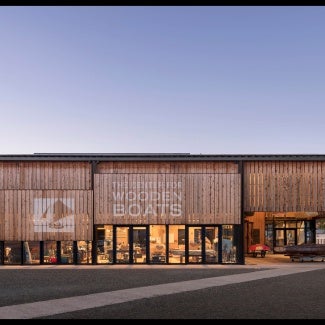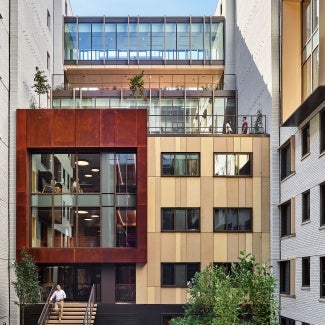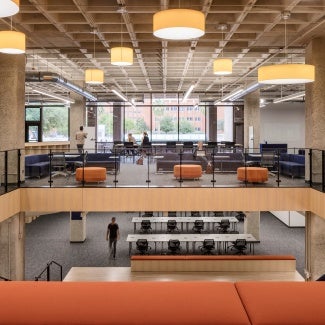John W. Olver Design Building, University of Massachusetts Amherst
The award-winning contemporary architecture of the John W. Olver Design Building at UMass Amherst unites the three design departments from different schools under one roof—fostering a new synergy across the disciplines.

Project highlights: John W. Olver Design Building, University of Massachusetts Amherst
- Architect: Leers Weinzapfel Associates
- Owner: University of Massachusetts - Amherst
- Location: Amherst, Mass.
The Olver Design Building, a new collaborative facility at University of Massachusetts, Amherst, unites three design departments from different schools under one roof. In doing so, the building fosters new synergy across the disciplines of architecture, building and construction technology, and landscape architecture on the university’s flagship western Massachusetts campus.
Drawing inspiration from various agrarian patterns found throughout the state, the new building links the more formal, large-scale Haigis Mall, built in 1975, to the informal and intimate space of the historic campus. From its sloping site, the building acts as a new pathway through the campus, while its design evokes the school’s roots as a land-grant college where local pastures and fields once served as its labs and working classrooms.
The LEED Gold-certified building was constructed with a cutting-edge composite cross-laminated timber system, taking its cues from the building construction technology department’s research on mass timber. It is the largest such building in the United States, demonstrating the university’s commitment to sustainability and innovation. The building’s envelope functions as a protective weather jacket that shields its wood structure. A durable rain screen enclosure composed of copper anodized aluminum panels and vertical windows suggest the patterns of historic tobacco barns and the region's forests.
Inside the building, the team shaped an ascending band of makerspaces, studios, faculty offices, and classrooms around a sky-lit commons to form a central space for collaboration. The commons, intended for gatherings and presentations, features a stepped-seating area and a ceremonial cross-laminated timber stair that spans two stories. Elsewhere, exposed timber columns, ceiling slabs, and cross-bracing bolster the building’s warm and rustic atmosphere. The building’s mechanical systems are revealed within the labs and teaching spaces, allowing them to serve as teaching tools for the university’s future architects, planners, and engineers.
As the building’s spiritual heart, the commons functions as a three-sided courtyard that spills out through the building’s cafe and entry to invite the rest of the campus in. A roof terrace perched above the commons is its outdoor counterpart, providing an open-air classroom for the landscape architecture program. It is reminiscent of an alpine garden, featuring wild-harvested sod, bare-root plants, and young evergreens.
The design team and the university have widely shared lessons learned throughout the design and construction process. The team’s work has been published nearly 30 times, shared at national and international conferences, and featured in the Timber City exhibition at the National Building Museum. In 2017 the Wall Street Journal noted that the building has helped “lay the foundations for the smart use of mass timber in ways that will soon enrich, and transform, our environment.”
Project team & Jury
Mass Timber Design: Leers Weinzapfel Associates (Tom Chung FAIA LEED BD+C)
Designers: Leers Weinzapfel Associates (Irene Kang, Taehoon Lee, Juliet Chun AIA, Zhanina Boyadzhieva AIA, Carolina Gutierrez)
Interior Design: Leers Weinzapfel Associates
General Contractor: Suffolk
Sustainability and Lighting Consultant: Atelier Ten
Engineer: BVH Integrated Services
Engineer - Structural: Equilibrium Consulting
Engineer: Nitsch Engineering - WBE
Engineer - Structural Engineer of Record: SGH
Landscape Architect: STIMSON
Ashley Wilson, FAIA, Chair, Ashley Wilson Architect, Alexandria, Va.
Jose Leo Arango, Assoc. AIA, EYP, District of Columbia
Randall Deutsch, FAIA, University of Illinois at Urbana-Champaign School of Architecture, Champaign, Ill.
Gabriel Ignacio Dziekiewicz, AIA, DesignBridge, Chicago
Teresa Jan, AIA, Multistudio, San Francisco
Luis Nieves-Ruiz, East Central Florida, Regional Planning Council, Orlando, Fla.
Zakiya Wiggins, AIA, LS3P, Raleigh, N.C.
The Architecture Award program celebrates the best contemporary architecture regardless of budget, size, style, or type. These stunning projects show the world the range of outstanding work architects create and highlight the many ways buildings and spaces can improve our lives.
Sixteen projects showcase the best contemporary architecture.













